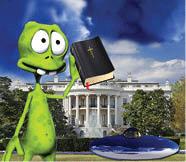
 ARISTOTLE taught the people of his day that the earth was fixed in place at the center of the universe. This view had religious appeal because it put humans at the center of everything and, therefore, indicated they are superior to all other things. For many years people believed that Genesis 1 supported this view. Humans were special and had dominion over everything else. Stars were fixed points of light, which gave directions and filled the night sky. The ancients knew that there were wandering stars. Unlike the fixed points of light, these “stars” moved in an arc across the sky. They were called “planets,” which meant “wandering stars.” In order to maintain the Aristotelian view, early astronomers invented “epicycles” — curves along which the wandering stars moved.
ARISTOTLE taught the people of his day that the earth was fixed in place at the center of the universe. This view had religious appeal because it put humans at the center of everything and, therefore, indicated they are superior to all other things. For many years people believed that Genesis 1 supported this view. Humans were special and had dominion over everything else. Stars were fixed points of light, which gave directions and filled the night sky. The ancients knew that there were wandering stars. Unlike the fixed points of light, these “stars” moved in an arc across the sky. They were called “planets,” which meant “wandering stars.” In order to maintain the Aristotelian view, early astronomers invented “epicycles” — curves along which the wandering stars moved.
 COPERNICUS proposed that the observations of astronomy would fit a model in which the earth circled the sun and rotated about its own axis. This was a huge change because now the earth was A world rather than THE world. The planets, or “wandering stars,” now had something in common with earth — we all circle the sun. Many saw all of this as a “Principle of Mediocrity” indicating that there is nothing special about our planet. By extension that meant there was nothing special about earth's inhabitants. If there is nothing special about earth, then it seemed logical to assume the wandering stars — Mercury, Venus, Mars, Jupiter, and Saturn — would be similar to earth in other ways, including intelligent life. The eighteenth-century French astronomer, Jerome Lalande wrote, “[T]here is every possible resemblance between the planets and the earth: Is it, then, rational to suppose the existence of living and thinking beings is confined to the earth?”
COPERNICUS proposed that the observations of astronomy would fit a model in which the earth circled the sun and rotated about its own axis. This was a huge change because now the earth was A world rather than THE world. The planets, or “wandering stars,” now had something in common with earth — we all circle the sun. Many saw all of this as a “Principle of Mediocrity” indicating that there is nothing special about our planet. By extension that meant there was nothing special about earth's inhabitants. If there is nothing special about earth, then it seemed logical to assume the wandering stars — Mercury, Venus, Mars, Jupiter, and Saturn — would be similar to earth in other ways, including intelligent life. The eighteenth-century French astronomer, Jerome Lalande wrote, “[T]here is every possible resemblance between the planets and the earth: Is it, then, rational to suppose the existence of living and thinking beings is confined to the earth?”
By 1800 most intellectuals believed in pluralism — that possibly every planet had intelligent beings living on it and that every star had planets, all of which housed intelligent life. There were even serious scientists — including William Herschel (who discovered Uranus), Carl Friedrick Gauss, David Brewster, and Norman Lockyer — who proposed that “solarians” lived on the sun. In 1895 the Italian astronomer  Giovanni Schiaparelli proposed intelligently-made features on Mars. This led to Percival Lowell's photographs of “canals” on Mars. The Wall Street Journal in 1907 wrote, “The most extraordinary development [of 1907] has been the proof afforded by astronomical observations of the year that conscious, intelligent life exists upon the planet Mars. . . . There could be no more wonderful achievement than this, to establish the fact of life upon another planet.”
Giovanni Schiaparelli proposed intelligently-made features on Mars. This led to Percival Lowell's photographs of “canals” on Mars. The Wall Street Journal in 1907 wrote, “The most extraordinary development [of 1907] has been the proof afforded by astronomical observations of the year that conscious, intelligent life exists upon the planet Mars. . . . There could be no more wonderful achievement than this, to establish the fact of life upon another planet.”
Atheists seized on this to attack the Bible and Christianity. Thomas Paine had written in his 1794 book Age of Reason, “[T]o believe that God created a plurality of worlds, at least as numerous as what we called stars, renders the Christian system of faith at once little and ridiculous, . . . From whence then could arise the solitary and strange conceit, that the Almighty, who had millions of worlds equally dependent on his protection, should quit the care of all the rest and come to die in our world because, they say, one man and one woman had eaten an apple!” Paine wrote that it was ridiculous to assume Jesus traveled from world to world in an “endless succession of death.”
The first nineteenth century scientist to oppose this pluralism was William Whewell of the University of Cambridge, who, interestingly, invented the word “scientist.” In an 1853 essay he pointed out that there was no sound evidence to support extraterrestrial intelligence. Alfred Russel Wallace, who was a co-discoverer of the theory of evolution, supported Whewell’s views and gave evidence to support it. In our time we have had attempts to resurrect this pluralism concept. Search for Extraterrestrial Intelligence (SETI) assumes an updated form of pluralism. Popular movies like Star Trek, Star Wars, Avatar, and others have built on this theme.
In the past fifty years, science has discovered that there is astounding diversity in our solar system. Some planets, like Jupiter, do not even have a surface but are made mostly of gas and limited amounts of liquid. For that reason we call them Jovian planets. Some planets are rocky like earth but have such a small mass they cannot hold a significant atmosphere. Earth has a large moon to stabilize its axis of rotation and influence our tides and plate tectonics, which are vital to the existence of life. The importance of shielding to protect the surface of a planet from bombardment by space debris, such as asteroids and comets, has become more obvious with new scientific observations. For example, we have seen Jupiter intercepting these objects before they could come close to earth. We have also seen how destructive such a collision can be with our studies of the asteroid that apparently did strike earth during the Cretaceous geologic period. That impact caused massive extinction of life — including the dinosaurs.
 Leading scientists are now challenging the concept of astronomical pluralism. An example is British physicist Stephen Webb's book If the Universe Is Teeming with Aliens . . . WHERE IS EVERYBODY? (Copernicus Publishing, 2002). Caltech professor of planetary astronomy, Mike Brown, who discovered Eris, the dwarf planet beyond Pluto, in an interview on NPR's “All Things Considered” (April 1, 2010) discussed “The Fruitless Search for Solar Systems Like Ours.” Astrophysicist Howard Smith wrote an article in Scientific American in 2011 titled “Alone in the Universe.”
Leading scientists are now challenging the concept of astronomical pluralism. An example is British physicist Stephen Webb's book If the Universe Is Teeming with Aliens . . . WHERE IS EVERYBODY? (Copernicus Publishing, 2002). Caltech professor of planetary astronomy, Mike Brown, who discovered Eris, the dwarf planet beyond Pluto, in an interview on NPR's “All Things Considered” (April 1, 2010) discussed “The Fruitless Search for Solar Systems Like Ours.” Astrophysicist Howard Smith wrote an article in Scientific American in 2011 titled “Alone in the Universe.”
The purpose of this article is not to say that there is no life in space. The Bible does not address this question, but it does make it clear that Jesus Christ is “the way, the truth, and the life” and no one comes to God except through him. I am reminded of a radio discussion and debate I had some 40 years ago on a program titled “Encounter.” The program was hosted by a rising star in the radio industry named Larry King. A caller asked the atheist representative on the show with me what he would do if a spaceship landed on the White House lawn and a little green man jumped out with a Bible in his hand and asked, “Has Jesus been here yet?”
 That question was rooted in the same misconception that Thomas Paine had about the nature of God, but I used it then and use it now to make a point. The message of Christ in Matthew 5 – 7 is a message of love, caring, peace, giving, compassion, sharing, supporting, and consistent concern for the well-being of others. If there are other sentient beings out there somewhere, they need to hear that message. Naturalism and moralities based on “survival of the fittest” do not work. If Christianity is tried, it does work.
That question was rooted in the same misconception that Thomas Paine had about the nature of God, but I used it then and use it now to make a point. The message of Christ in Matthew 5 – 7 is a message of love, caring, peace, giving, compassion, sharing, supporting, and consistent concern for the well-being of others. If there are other sentient beings out there somewhere, they need to hear that message. Naturalism and moralities based on “survival of the fittest” do not work. If Christianity is tried, it does work.
My atheist colleague on the show gave a short and intelligent answer. He said, “Punt.” Indeed we need to see the earth as special, needing to be cared for, and its people desperately needing what Jesus Christ has to offer.
Some information for this article is from “Life as We Know It,” by Michael J. Crowe, published in the Notre Dame Magazine, Autumn 2012, page 37.
Picture credits (top to bottom):
Aristotle: http://en.wikipedia.org/wiki/File:Aristoteles_Louvre.jpg.
Copernicus: http://en.wikipedia.org/wiki/File:Copernicus.jpg.
NASA, ESA, the Hubble Heritage Team (STScI/AURA), J. Bell (Cornell University), and M. Wolff (Space Science Institute, Boulder).
Roland Earnst.
Composite: Roland Earnst. © a. v. ley., © Harveys Art, and © Nataliia Natykach. All images from BigStockPhoto.com.
